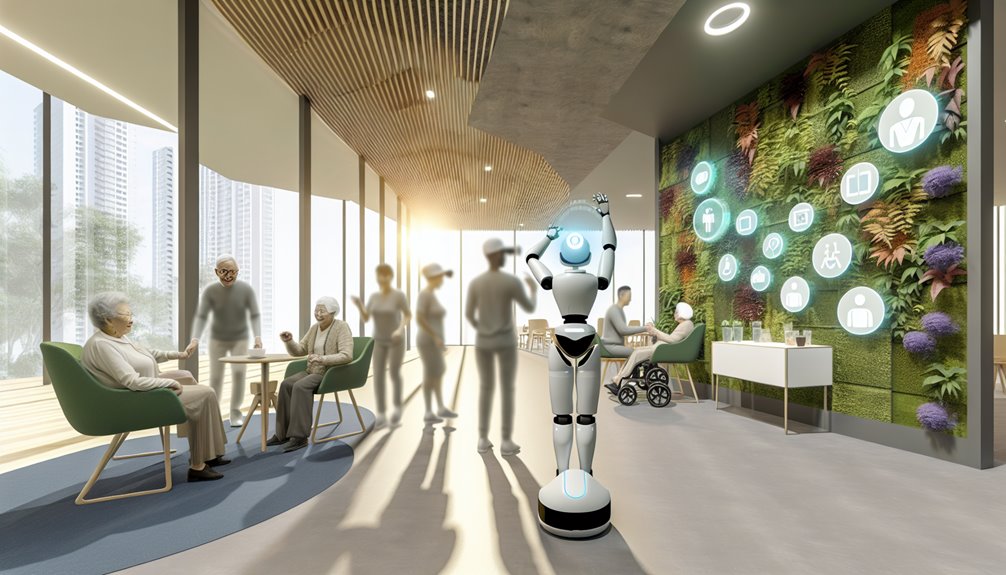You're entering a transformative era for senior care, where demographic changes and tech advancements drive investment trends. By 2030, 1 in 5 Americans will be over 65, increasing the demand for affordable, tech-enhanced housing. Innovations like remote monitoring and smart homes are enhancing senior independence. Financial models are evolving with public-private partnerships, affecting middle-income consumers. Solo agers need community-centric living solutions. Explore how these factors shape investments, influencing senior care's future.
Key Takeaways
- Public-private partnerships and subscription services will expand accessibility to senior housing.
- Technology investments like remote monitoring and smart home automation promise cost savings and better care.
- Over 600,000 new senior housing units are needed by 2030 to meet growing demand.
- Affordable co-housing and community-based models support solo agers and middle-income seniors.
- Long-term care insurance and reverse mortgages offer critical funding for sustainable senior living.
Demographic Shifts and Their Impact on Senior Care
As the demographic landscape shifts, the senior care industry faces significant transformation due to the aging population. By 2030, nearly 1 in 5 Americans will be over 65, creating a growing demand for diverse senior housing solutions. The aging population, especially those 80 and older, will reach approximately 19 million, emphasizing the urgent need for expanded accommodations. Middle-income seniors are doubling by 2029, highlighting the necessity for affordable, accessible senior living options. Additionally, solo agers, making up about 25% of older adults, encounter challenges like isolation, requiring targeted support in senior facilities. With over 40% experiencing memory impairment, the demand for memory care units surges, underscoring the importance of specialized services in meeting these evolving needs.
Technological Innovations Transforming Senior Living
While the senior care industry grapples with an aging population, technological innovations are reshaping the landscape to meet these challenges head-on. Remote monitoring devices and telehealth platforms enhance healthcare accessibility, enabling caregivers to track health metrics from afar, consequently revolutionizing service delivery. Smart home automation, including voice-activated devices and home security systems, supports senior independence by providing convenience and safety. Wearable health trackers foster accountability and motivation, promoting healthier lifestyles among residents. The integration of Electronic Health Records (EHRs) and care coordination platforms streamlines management and communication, enhancing overall care quality. As approximately 40% of seniors experience memory impairment, technology-driven memory care units are rapidly growing, ensuring specialized care and monitoring, thereby greatly improving the quality of life for aging adults.
Emerging Financial Models for Sustainable Growth
Despite the inherent challenges in financing senior care, innovative financial models are carving pathways to sustainable growth. You'll find that public-private partnerships and subscription services are making senior housing more accessible and affordable for aging adults. Long-term care insurance and reverse mortgages provide vital funding options, empowering families to tackle the costs of aging. Community-based funding initiatives are gaining momentum, fostering sustainability and affordability through local support. As the senior population expands, these emerging financial models play a pivotal role in ensuring sustainable care services. Integrating technology in senior care investments not only promises long-term savings but also enhances early health issue detection, reducing hospital visits and costs. Meeting the demand for over 600,000 new senior housing units by 2030 remains essential.
Adapting to the Needs of Solo Agers and Middle-Market Consumers
Given the evolving landscape of senior care, adapting to the needs of solo agers and middle-market consumers has become essential for sustainable growth. Solo agers, making up about 25% of older adults, face challenges like isolation, driving demand for community connections. Senior living organizations are now offering tailored services such as financial planning and community engagement to address these needs. With the middle-income senior population set to double by 2029, creating affordable, market-rate housing with flexible service offerings is critical. Over 40% of individuals aged 55-64 lack retirement savings, necessitating affordable pricing models. Emphasizing co-housing and inclusive service models not only supports solo agers but also appeals to those seeking community-centric living arrangements.
Strategies for Enhancing Quality of Life and Aging in Place
To enhance the quality of life for seniors and support their desire to age in place, the integration of innovative strategies is vital. Home care improvements, such as modifications and remote monitoring systems, guarantee safety and accessibility, allowing seniors to maintain independence. With approximately 90% of seniors wanting to remain in their homes, community initiatives play a significant role in providing affordable housing and support. Co-housing models and accessory dwelling units (ADUs) foster social interaction and address affordability. Technology, through assistive devices and smart home systems, boosts quality of life and safety. Volunteer assistance and local government programs further enable successful aging in place, enhancing well-being by creating a supportive and inclusive environment.
Conclusion
Imagine senior care as a tree, its roots firmly planted in demographic shifts and its branches reaching toward a future enriched by technology. You're investing in this tree's growth, nurturing it with emerging financial models that guarantee sustainability. The leaves symbolize innovative strategies for solo agers and middle-market consumers, adapting to their unique needs. As these branches stretch further, they enhance quality of life, allowing seniors to age gracefully in place, supported by a robust, forward-thinking ecosystem.

